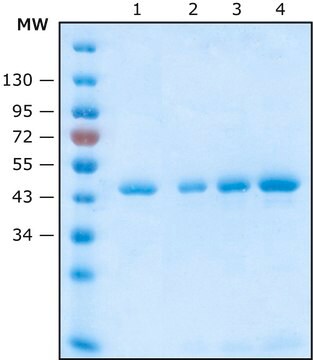OGS569
PSF-CMV-MUIGG1 - MOUSE IGG1 HEAVY CHAIN ANTIBODY PLASMID
plasmid vector for molecular cloning
Synonym(e):
cloning vector, expression vector, molecular cloning vector, plasmid, plasmid vector, snapfast vector, vector
About This Item
Empfohlene Produkte
Form
buffered aqueous solution
Mol-Gew.
size 5223 bp
Bakterienauswahl
kanamycin
Replikationsursprung
pUC (500 copies)
Peptidspaltung
no cleavage
Promoter
Promoter name: CMV
Promoter activity: constitutive
Promoter type: mammalian
Reportergen
none
Versandbedingung
ambient
Lagertemp.
−20°C
Allgemeine Beschreibung
Promoter Expression Level: This plasmid contains the mammalian CMV promoter to drive gene expression. We have tested all of our mammalian promoters in a range of cell types and CMV is consistently the strongest in those we have studied. However there are many reports of the CMV promoter demonstrating silencing by methylation in long-term culture.
Anwendung
To enable this immediately upstream of the constant region coding sequence there is a BseRI restriction site. This is a type-IIS restriction enzyme that binds in one position (CAGCAG) and then cleaves a specific number of nucleotides away from the binding site regardless of the sequence at the cleavage point. We use this site in all of our antibody expression cassettes in the same position. In this plasmid cutting with BseRI will result in an overhang consisting of the first two nucleotides of the first codon of the constant region. This means that any variable region with the same overhang at its 3 prime end can be ligated into this plasmid when used in conjunction with any 5 prime site (NotI-NcoI). To add this overhang the variable region must be PCR amplified to contain any of the following sites at its 3 prime end: BseRI BsgI BtsI or BsrDI. By using this system it allows antibody variable regions to PCR amplified and fused to any of our constant region plasmids without having to re-synthesise the entire antibody expression cassette each time.
Sequenz
Hinweis zur Analyse
Ähnliches Produkt
Lagerklassenschlüssel
12 - Non Combustible Liquids
Flammpunkt (°F)
Not applicable
Flammpunkt (°C)
Not applicable
Analysenzertifikate (COA)
Suchen Sie nach Analysenzertifikate (COA), indem Sie die Lot-/Chargennummer des Produkts eingeben. Lot- und Chargennummern sind auf dem Produktetikett hinter den Wörtern ‘Lot’ oder ‘Batch’ (Lot oder Charge) zu finden.
Besitzen Sie dieses Produkt bereits?
In der Dokumentenbibliothek finden Sie die Dokumentation zu den Produkten, die Sie kürzlich erworben haben.
Unser Team von Wissenschaftlern verfügt über Erfahrung in allen Forschungsbereichen einschließlich Life Science, Materialwissenschaften, chemischer Synthese, Chromatographie, Analytik und vielen mehr..
Setzen Sie sich mit dem technischen Dienst in Verbindung.








